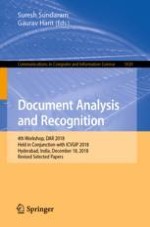2019 | Book
Document Analysis and Recognition
4th Workshop, DAR 2018, Held in Conjunction with ICVGIP 2018, Hyderabad, India, December 18, 2018, Revised Selected Papers
Editors: Assoc. Prof. Suresh Sundaram, Assoc. Prof. Gaurav Harit
Publisher: Springer Singapore
Book Series : Communications in Computer and Information Science
